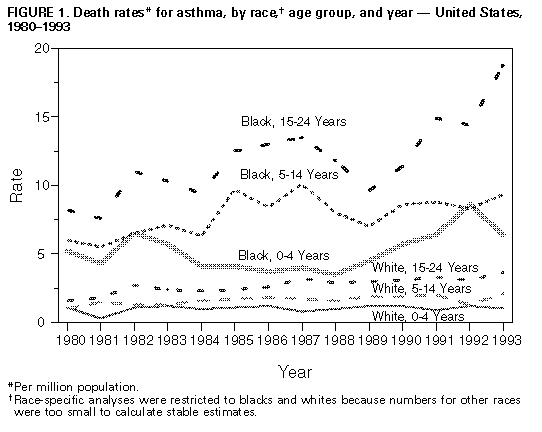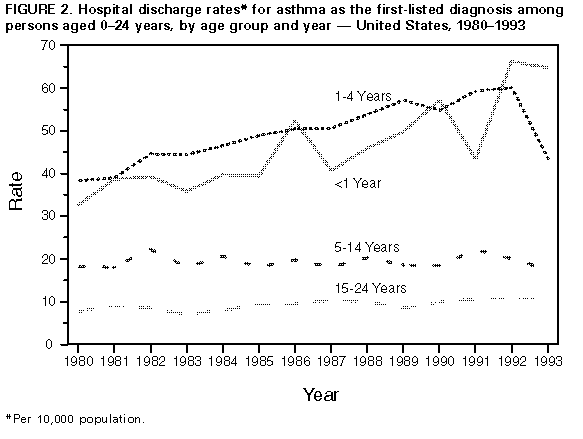 |
|
|
|
|
|
|
| ||||||||||
|
|
|
|
|
|
|
||||
| ||||||||||
|
|
|
|
|
Persons using assistive technology might not be able to fully access information in this file. For assistance, please send e-mail to: mmwrq@cdc.gov. Type 508 Accommodation and the title of the report in the subject line of e-mail. Asthma Mortality and Hospitalization Among Children and Young Adults -- United States, 1980-1993Asthma is the most common chronic illness in childhood and is characterized by variable airflow obstruction with airway hyperresponsiveness. In the United States, asthma affects an estimated 14-15 million persons, including 4.8 million (6.9%) aged less than 18 years (1). In 1993, asthma accounted for an estimated 198,000 hospitalizations and 342 deaths among persons aged less than 25 years. To characterize national trends in mortality and hospitalizations attributable to asthma among children and young adults (persons aged less than 25 years) during 1980-1993, CDC analyzed mortality data from its multiple cause-of-death files and hospitalization data from the National Hospital Discharge Survey. This report summarizes the results of that analysis, which indicate that asthma-related mortality and hospitalization rates are increasing among persons aged less than 25 years. Deaths attributed to asthma were based on the International Classification of Diseases, Ninth Revision (ICD-9), codes 493.0-493.9. Asthma-related hospitalizations were classified as those in which asthma was the first-listed discharge diagnosis. Data were analyzed by race because of previously reported differences in race-specific rates of death and hospitalization attributed to asthma (2). Race-specific analyses were restricted to blacks and whites because numbers for other races were too small to calculate stable estimates. During 1980-1993, asthma accounted for 3850 deaths among persons aged 0-24 years. The annual age-specific asthma death rate increased 118% (from 1.7 to 3.7 per million population). During this period, death rates for asthma consistently were highest among blacks aged 15-24 years (Figure_1). Although the death rate among children aged 0-4 years increased slightly during 1980-1993 (from 1.8 to 1.9 per million population), the rate in 1993 had decreased from that in 1992 (2.4 per million population). In 1993, among children aged 0-4 years, blacks were six times more likely to die from asthma than whites, and boys were 1.4 times more likely than girls. Among children aged 5-14 years, the asthma death rate nearly doubled from 1980 to 1993 (from 1.7 to 3.2 per million population). In 1993, among children aged 5-14 years, blacks were four times more likely than whites to die from asthma, and boys were 1.3 times more likely than girls. Among persons aged 15-24 years, the asthma death rate doubled from 1980 to 1993 (from 2.5 to 5.2 per million population). In 1993, among persons aged 15-24 years, blacks were six times more likely than whites to die from asthma, and males were 1.5 times more likely than females. From 1980 to 1993, the annual hospitalization rate for asthma among persons aged 0-24 years increased 28% (from 16.8 to 21.4 per 10,000 population). Hospitalization rates consistently were highest among blacks. In 1993, among persons aged 0-24 years, blacks were 3.4 times more likely than whites to be hospitalized for asthma. Although the rate of hospitalization for asthma was highest and increased the most among children aged less than 1 year (from 35.6 to 64.7 per 10,000 population) (Figure_2), the rate in 1993 had decreased from that in 1992 (66.3 per 10,000 population). Among children aged 1-4 years, the rate of hospitalization increased during 1980-1992 (from 38.3 to 60.1 per 10,000 population), but decreased in 1993 (43.6 per 10,000 population) because of a decrease in the number of participating hospitals. In 1993, boys aged less than 5 years were 1.7 times more likely than girls to be hospitalized for asthma. Among persons aged 5-24 years, the rates of asthma hospitalization remained relatively constant during 1980-1993. In 1993, among persons aged 5-14 years, boys were 1.3 times more likely than girls to be hospitalized for asthma, and among those aged 15-24 years, females were 2.1 times more likely than males to be hospitalized. Reported by: Air Pollution and Respiratory Health Br, Div of Environmental Hazards and Health Effects, National Center for Environmental Health, CDC. Editorial NoteEditorial Note: Asthma is a multifactorial disease that has been associated with familial, infectious, allergenic, socioeconomic, psychosocial, and environmental factors. Decreases in pulmonary functions and exacerbations of asthma have been associated with ambient air pollutants (e.g., ozone, sulfur dioxide, nitrogen dioxide, acid aerosols, and particulate matter) (3), indoor pollutants (e.g., tobacco smoke), and allergens (e.g., dust mites) (4). Approximately 25% of children in the United States reside in areas that exceed the federal standard for ozone (5). Although asthma-associated mortality has increased among persons aged less than 25 years, hospitalizations for asthma have increased primarily among children aged less than 5 years. The increase among young children may be related to changes in diagnostic practices, changes in coding and reimbursement, or increases in morbidity (6). One of the national health objectives for the year 2000 is to decrease asthma morbidity, as measured by a reduction in hospitalizations for asthma, among children aged less than or equal to 14 years to no more than 18.3 per 10,000 population (baseline: 22.9 per 10,000 persons) (objective 11.1) (7). In 1993, the hospitalization rate for children aged less than or equal to 14 years was 28.0 per 10,000 population. Hospitalizations for and mortality related to asthma can be prevented, in part, by improving surveillance, diagnostic measures, and patient management; providing patient education; targeting high-risk populations (8); and evaluating interventions in the home environment (e.g., reducing levels of house dust mites and exposure to environmental tobacco smoke) (6,8,9). Additional information about these prevention measures or other asthma-prevention materials are available from the National Heart, Lung and Blood Institute Information Center, telephone (301) 251-1222, or the local offices of the American Lung Association, telephone (800) 586-4872 or (212) 315-8700. References
Figure_1  Return to top. Figure_2  Return to top. Disclaimer All MMWR HTML versions of articles are electronic conversions from ASCII text into HTML. This conversion may have resulted in character translation or format errors in the HTML version. Users should not rely on this HTML document, but are referred to the electronic PDF version and/or the original MMWR paper copy for the official text, figures, and tables. An original paper copy of this issue can be obtained from the Superintendent of Documents, U.S. Government Printing Office (GPO), Washington, DC 20402-9371; telephone: (202) 512-1800. Contact GPO for current prices. **Questions or messages regarding errors in formatting should be addressed to mmwrq@cdc.gov.Page converted: 09/19/98 |
|||||||||
This page last reviewed 5/2/01
|